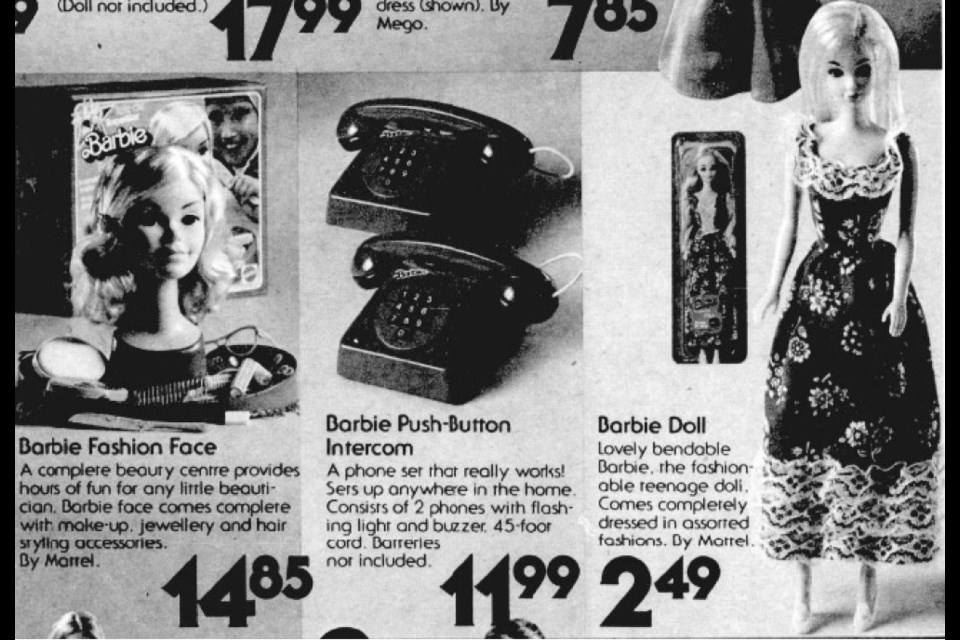In a house of three girls and one boy, all was relative peace and calm in Barbieland until my brother got bored and our mother insisted we allow him to play, too.
Mayhem quickly followed when his gang of GI Joes began robbing, plundering, and driving Barbie’s car too fast until it crashed.
I smile at the memory now, but we girls were less than pleased at the time. Thousands of hours were spent creating elaborate lives for our Barbie dolls, much of it fashioned after the story lines of our mother’s daily soap, or the tabloid goings-on of Cher and other celebrities of the day.
A discarded cardboard box was stacked with others and decorated with scraps of wallpaper. Photos of clocks and wall art were clipped from the Sears catalogue and pasted onto the walls. Little green plastic strawberry baskets made excellent cribs for Barbie’s baby dolls. Does anyone remember how a discarded Kleenex box could be folded into a neat couch just right for Barbie?
If you haven’t guessed already, I saw the Barbie movie this week. I thought it was fantastic, and not at all what I was expecting, and it brought me back to the days when Barbie was everything.
During the 1960s, just as Barbie was gaining a foothold in the playtime lives of Barrie children, Eileen Dixon was writing a women’s interest column called Skirting the Bay for the Barrie Examiner. This was her take in 1965.
“For those parents with children approaching the Barbie stage, you can expect the craze to take over completely with your daughter when she is on the brink of tossing Chatty Cathy into the darkest corner of her closet.”
Barbie, named for Barbara Handler, daughter of Mattel co-founder Ruth Handler, was born in 1959. The doll made rapid inroads to Barrie, and elsewhere, due to massive television advertising, which was unusual in that era.
“When Barbie took up residence with us, she had only the clothes she arrived in. Now she has a small cupboard of her own and a costume for every stage possible of her very busy life. Thanks to relatives on birthdays and at Christmas. When Barbie goes out for the evening, she has no less than six gowns to choose from, where I have two, and she has a white fox fur stole and a mink to boot.”
A decade later, the Barbie doll was known as the world’s biggest-selling toy. In 1974, she was making $100 million a year for Mattel. Of course, my sisters and I cared about none of that and only concerned ourselves with how to get our father to buy us more accessories for our Barbies.
If you had deep pockets, there was virtually no end to what fun Barbie items you could buy. We were farm girls and yet had a fair collection. Up the road from us lived a girl of my age whose father was then vice-president of Coca-Cola Canada. Let me tell you: She had a dazzling array of everything Barbie, or I, could ever dream of.
When we visited back and forth, we arrived with most of our Barbie goods in tow. The day would then be spent immersed in a world of imagination, dressing and narrating the lives of our dolls as they took on the roles of rock stars, royalty, or women with glamorous careers.
None of our Barbie dolls survived to become collectors’ items. No, they were well played with, as they were intended to be. Some endured more than others as they suffered some extreme haircuts and unwanted tattoos at the hands of our brother.
I still remember when I deliberately cast Barbie aside. It was just before I entered high school, and I was thinking secondary school girls didn’t play with Barbies, so I made the decision to leave Barbie behind. There was a little bit of sadness in that decision as Barbie had been such a big part of my life.
Each week, the Barrie Historical Archive provides BarrieToday readers with a glimpse of the city’s past. This unique column features photos and stories from years gone by and is sure to appeal to the historian in each of us.



